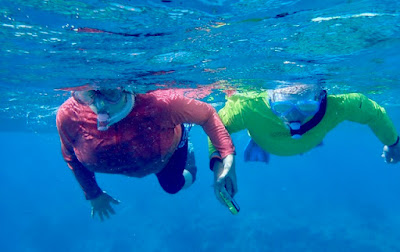We cut our trip short and hurried home to self-quarantine
and isolate ourselves from the coronavirus.
We never had a chance to blog about our watery adventures in the
Keys. Today is a cool, grey, rainy March
day in Virginia, the perfect weather for reminiscing about the beautiful blue-green
water, brilliant sunshine and incredible creatures of the Keys.
 |
| Beach walk on Bahia Honda during a kayak break |
 |
| We could see the marina from our campsite |
We stayed at Sunshine Key RV Resort and Marina. It is just south of the 7-mile bridge on Ohio
Key. Ohio Key is small, 2/3rds of it is
the campground and the remaining 1/3rd is wetland and bird sanctuary. Across a narrow channel is the next key with
gorgeous Bahia Honda State Park. The
locals call it “Baya Honda”. We were
there 12 days.
 |
| French Angelfish |
 |
| A Parrotfish and some Tangs |
Snorkeling
We chartered Captain Brian from Keys Boat Tours to take us
out for a snorkel at Looes Key. The undersea
coral reef is a magical world with brightly colored fish, gently undulating
soft coral purple sea fans, and the occasional ray and barracuda. The day was windy and the sea surface was
choppy, which cut our snorkel short.
What we did get to enjoy was very special.
 |
| Finally, a Manatee |
Finally, a Manatee
If you have been reading our blog for a while, you know that
our Florida trips are punctuated by near misses in Manatee sightings in the
wild. When we returned to the marina
after our snorkel, a Manatee came by for a visit. It was a huge, slow-moving animal, graceful
in the water.
Here is a movie of our manatee
Manatees spend part of the year in fresh water and love to
drink fresh water when they are living in salty water. This one came over to the boat as our captain
flushed his engine with fresh water and drank the water. It gave us a chance to observe the manatee up
close.
Because the manatees can not get away from boat propellers
quickly, and because marinas have a lot of boat traffic, it is unsafe to spray
a hose of fresh water to attract a manatee in a marina. You might put the animal at risk. However, there are sources of fresh water in
marinas, so the manatee wander in from time to time for that and other reasons known
only to the manatee. We were told that
up to 4 manatee have been seen in this marina at one time.
 |
| Leaving the marina |
Kayaking
Our own kayaks needed repairs, so we rented kayaks one day,
and borrowed friend’s kayaks on another day to go out for paddles. We circumnavigated tiny Ohio Key and paddled
over to Bahia Honda where we walked on the beach.
 |
| Beautiful Bahia Honda |
 |
| Mangrove |
We observed a stingray and a nurse shark swimming through
the water. Ibis, herons and egrets
stalked in the shallow water. Pelicans
swooped overhead, some so close we could hear their wings moving through the air
as they passed us. There were cormorants everywhere. We poked the bows of
our boats into the mangrove thickets.
 |
| Magnificent Frigatebird - the white tells us it is a female |
Magnificent Frigatebird
The Magnificent Frigatebird is an enormous animal, with a 7
foot wing span. You can see its
distinctive shape soaring high overhead when you are in the Keys. They do not have waterproof feathers, so do
not fish for food, instead they swoop down and steal food from other birds. They also harass other birds until they
regurgitate their meals and then the frigatebird catches the regurgitated food
in mid-air. Despite this revolting way
of shopping for groceries, they are magnificent to watch gliding on the ocean thermals
high overhead. We’ve only ever seen them
in the Keys, and we got to see several this trip as well.
 |
| Dana and a pelican friend |
 |
| Got too close... |
The Trip Home
Once we decided that we needed to return home instead of
continuing our trip, we drove 1200 miles in 2 ½ days. We
decided not to stay in campgrounds on the way home, instead camping overnight
in highway rest areas, along with other RVers and truckers. We are self-contained so all we needed was a long
place to park. This was a new and
pleasant experience for us. We planned
our gas stops when we were near empty, filling up 70+ gallons at a time. Hearing that grocery stores had been slammed
at home, we stopped at the Food Lion in tiny Micro NC to stock up on eggs, milk
and fresh vegetables. A very different
trip than the meandering, relaxed way we usually travel.
 |
| Orange marking tells us this is a breeding male cormorant |
 |
| Juvenile cormorants |
 |
| Goodbye paradise |

















































